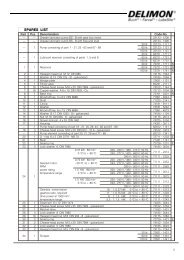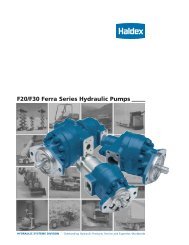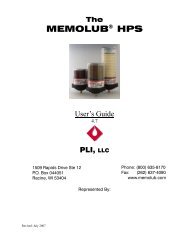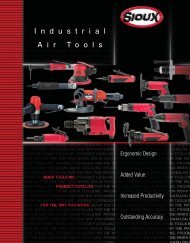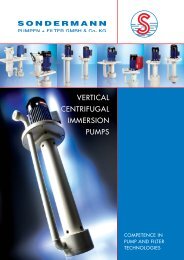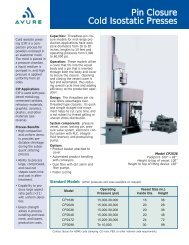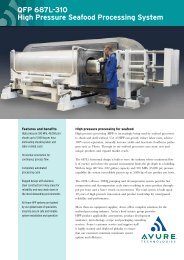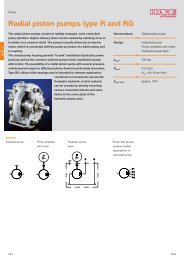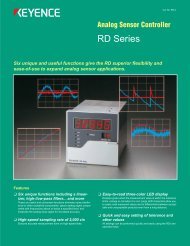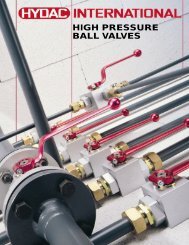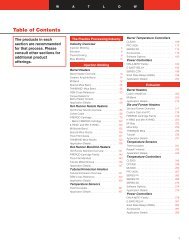Sun Hydraulics Catalog - BIBUS SK, sro
Sun Hydraulics Catalog - BIBUS SK, sro
Sun Hydraulics Catalog - BIBUS SK, sro
You also want an ePaper? Increase the reach of your titles
YUMPU automatically turns print PDFs into web optimized ePapers that Google loves.
COUNTERBALANCE CARTRIDGE VALVE TECHNICAL INFORMATIONAdjustment RangeA, H: 70-280 bar – Standard Setting 210 barB, I: 30-105 bar – Standard Setting 70 barC, J: 140-350 bar – Standard Setting 210 barD, K: 70-175 bar – Standard Setting 140 barF: 70-175 bar – Standard Setting 140 barG: 140-420 bar – Standard Setting 280 barCracking Pressure of Reverse Free Flow CheckValves with pressure range A, B, C, D have a .3 barcracking pressure for the reverse free flow check.All others are 1.5 to 3 bar cracking pressure. Inapplications with loads that change quickly, highercracking pressures are recommended.Influence of Back PressurePressure downstream of the counterbalance valve(port 2) is additive to the setting with the given factor(influence of back pressure). The setting is the loadpressure (on port 1) that opens the valve with no pilotpressure (on port 3).In applications with proportional valves that throttlethe return flow, <strong>Sun</strong> recommends using ventedcounterbalance valves (CW** or CA**). CW**counterbalance valves have a spring chamber drainedto port 4. CA** valves have an atmospherically ventedspring chamber. CA** valves can be used when someexternal leakage (drops) is acceptable. The springchamber cannot corrode due to splash water.StabilityCircuits with counterbalance valves can be unstable.In most cases the circuit will be more stable afterreplacing the counterbalance valve with a valve thathas a lower pilot ratio or is restrictive or smaller. Pilotratio 3:1 is very common and works in most cases.Notes (see numbers within table at right)(1) Fully restrictive valves have a very limited flowcapacity as relief valves. Counterbalance restrictivevalves can be used to limit the pressure due to thermalexpansion.(2) These counterbalance valves have an internalbleed-off orifice between port 3 and 2 to reduce theeffective pilot ratio. The pilot flow between port 3 and 2is about .6 L/min. at 70 bar pilot pressure.(3) These valves have no sealed pilot piston. Theleakage from port 3 to port 2 is .93 L/min. at 70 barpilot pressure.(4) These are valves with no sealed pilot piston.Leakage between port 3 and port 2 is between .03and .3 L/min. The high leakage occurs when the pilotpressure is half the load pressure or higher.CBCA and CBEA are available with sealed pilot piston(these would be custom numbered valves).COUNTERBALANCE CARTRIDGE VALVES / NON-VENTEDFully Restricted Series 1CavityT-11ANominal Capacity 10 L/min.Model CodeCBABCBAACBAGRestrictive (1) Series 1CavityT-11ANominal Capacity 20 L/min.Model CodeCBBY (2)CBBACBBGCBBH (3)Semi-restrictive Series 1CavityT-11ANominal Capacity 40 L/min.Model CodeCBBBCBBLCBBCCBBDStandard Series 1CavityT-11ANominal Capacity 60 L/min.Model CodeCBCBCBCY (2)CBCLCBCA(3)CBCG (3)CBCH (4)COUNTERBALANCE CARTRIDGE VALVES / VENTEDStandard Series 1CavityT-11ANominal Capacity 60 L/min.Model CodeCACKCACLCACACACGAdjustment RangeH; I; A; BH; I; A; BJ; K; C; DAdjustment RangeH; I; A; BH; I; A; BJ; K; C; DJ; K; C; DAdjustment RangeH; I; A; BJ; K; C; DH; I; A; BJ; K; C; DAdjustment RangeH; I; A; BH; I; A; BJ; K; C; DH; I; A; BJ; K; C; DJ; K; C; DAdjustment RangeH; IF; GH; IF; GAll Model Codes shown in boldface type are in thecounterbalance section of this catalogue. Consultwww.sunhydraulics.com for our complete line ofcounterbalance cartridge products.Cavity AdaptersT-17A to T-2A: XHOC-BXNT-17A to T-11A: XHOC-EXNT-19A to T-17A: XJOC-GXNT-23A to T-22A: XPOC-NXNT-24A to T-23A: XQOC-PXNStandard Series 1CavityT-21ANominal Capacity 60 L/min.Model CodeCWCKCWCLCWCACWCGAdjustment RangeH; IF; GH; IF; GVisit www.sunhydraulics.com for current list pricing and complete technical information on all <strong>Sun</strong> products.Int’l Shortcut <strong>Catalog</strong>ue #999-901-312 52



